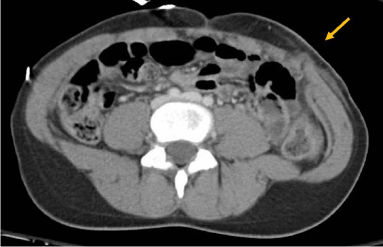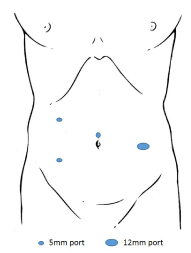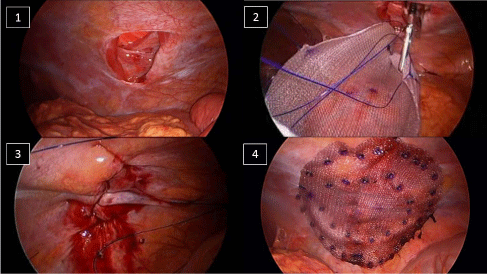Case Report
Technical Report: Laparoscopic Repair of Traumatic Ventral Hernia
Ikoma N* and Harvin JA
Department of Surgery, University of Texas MD Anderson Cancer Center, USA
*Corresponding author: Naruhiko Ikoma, Department of Surgery, University of Texas MD Anderson Cancer Center, Houston, Texas, USA
Published: 19 Sep, 2016
Cite this article as: Ikoma N, Harvin JA. Technical Report:
Laparoscopic Repair of Traumatic
Ventral Hernia. Clin Surg. 2016; 1:
1123.
Abstract
Traumatic Ventral Hernia (TVH) is a type of hernia that occurs after high impact blunt injury to the abdominal wall. In the current report, we present a 27-year-old patient who presented to our trauma
center after motor vehicle collision. She was diagnosed with TVH lateral to the linea semilunaris at
the level of umbilicus, involving the transversus abdominis, internal oblique, and external oblique
muscle. She underwent successful laparoscopic TVH repair. Laparoscopic TVH repair is a safe
and effective strategy, especially for stable patients with a small defect. Primary closure and mesh
placement are recommended, and a laparoscopic technique is a safe and effective procedure.
Keywords: Laparoscopic hernia repair; Traumatic ventral hernia
Introduction
Traumatic Ventral Hernia (TVH) is a type of hernia that occurs after high impact blunt injury to the abdominal wall. TVH is rare, and its occurrence is about 0.8% [1,2]. TVH occurs following blunt trauma including handle bar injury (35%), seatbelt injury (19%), and crush injury (25%) [3]. CT scan has been commonly used for diagnosis [4]. Owing to the infrequent incidence, the surgical technique and its timing of repair are not standardized yet. We herein report a case with symptomatic lateral TVH which was repaired successfully repaired by laparoscopic technique.
Case Presentation
Patient is a 27-year-old female with no past medical history who was transferred to our trauma center after suffering motor vehicle collision. She was a restrained driver involved in a multi- vehicle pile-up which required prolonged extrication. On arrival, she had a GCS 13 with normal vital sign. Physical examination revealed soft tissue contusion and abrasions to left lower quadrant, unstable left leg with laceration. CT scan revealed grade 2 splenic injury with minimal perisplenic fluid collection and left lower abdominal wall tear lateral to the linea semilunaris at the level of umbilicus, involving the transversus abdominis, internal oblique, and external oblique muscle (Figure 1). Her other injuries included; mild subarachnoid hemorrhage, non displaced lumbar spine transverse process fractures, left open tibia-fibular fracture, and left metatarsal fractures. Patient was admitted and underwent intramedullary nailing of the left tibia and fibula on the next morning. Her subarachnoid hemorrhage was stable on the repeat CT scan, and patient was stable in good condition. However, she had become more progressive symptomatic, including increased pain and episodes of herniation. She was decided to undergo laparoscopic ventral hernia repair on hospital day 7.
Treatment and follow-up
After pneumoperitoneum was established via a right upper
quadrant, the hernia was inspected via right lateral 5-mm port
(Figure 2). Approximately 4-cm long and 3 cm wide defect of all 3
layers of the lateral abdominal wall was clearly visualized (Figure
3). An incision was made over the hernia defect and a 12-mm port
placed through the defect. Four 0-Prolene sutures were placed in the
middle of each side of 11 x 9 cm piece of synthetic mesh, which was
rolled up and placed in to the abdomen through the 12-mm port.
The hernia defect was closed with multiple 1-PDS sutures placed by
Carter-Thomason suture passer, including all 3 layers of abdominal
wall fascia (Figure 2). Then, Carter-Thomason suture passer was used
to retrieve the four transfascial sutures and secure the mesh to the
abdominal wall. Laparoscopic tacker was used to secure the rest of
the mesh in a double crown manner. Patient tolerated the procedure
well without complications. She did well post-operatively, and was
discharged on post-operative day 1 with good pain control.
Figure 1
Figure 1
CT scan.
CT scan revealed abdominal wall tear involving the transversus abdominous, internal oblique, and external
oblique musculature on the left
Figure 2
Figure 2
Port placement.
12 mm port was placed through the abdominal wall defect to minimize fascial penetration. Mesh was inserted through this port into abdominal cavity.
Figure 3
Figure 3
Intraoperative pictures.
1. Abdominal wall tear was clearly visualized by laparoscopy
2. Mesh was inserted through the 12 mm port
3. En-masse transfascial interrupted sutures were placed to close abdominal wall
4. Mesh was tacked circumferentially in double-crown fashion
Discussionn
A blunt TVH is caused by a trauma insufficient to penetrate the
skin, but able to disturb muscular and fascial tissues. This possibly is
caused by three mechanisms: an increased intraabdominal pressure,
a direct injury, a tangential shearing force on muscular layer, or
combination of those [5]. Traumatic abdominal wall hernias have
been reported to occur in a variety of regions. The most common
are the lower quadrants, lateral to the rectus sheath, and the inguinal
area, often secondary to handlebar and seat belt injuries [6].
Since the first TVH was reported in 1906, multiple case reports or
case series have been reported. But number of reports of laparoscopic
repair of TVH is still limited, and the surgical technique is still not
standardized [7]. We experienced a case with a traumatic ventral
hernia at left lower quadrant lateral to rectus muscle, which was
repaired by primary fascial defect closure with under-lay mesh
placement by laparoscopic technique. The technical key points of
this patient’s repair were; starting laparoscopic inspection from
contralateral side of hernia which provides excellent visualization of
the defect, 12-mm port placement through the ventral hernia which
prevents unnecessary fascial injury for mesh insertion, and primary
defect closure with Carter-Thompson suture passer which minimizes
skin incision. This technique can be applicable for majority of
traumatic ventral hernias and can be safely performed. In case the
defect is too big for primary closure, component separation technique
can be considered.
Timing of TVH repair should be decided case-by-case basis
regarding the size, location, symptoms of the hernia, risk of
incarceration, and mostly patient’s condition associated with
concomitant injuries. In cases who requires emergent laparotomy,
simultaneous repair of ventral hernia should be considered during
the same operation if feasible. In case of stabilization without surgical
intervention, repair should be delayed [8]. However, since the risk
of incarceration exists and delay of repair causes muscle contraction
which makes future repair difficult, repair of TVH is recommended at
the earliest timing when the patient’s condition allows.
Repair of TVH can be performed as open, local exploration, and
laparoscopic technique [7]. Among them, laparoscopic technique
is a good option, which provides excellent abdominal exploration
and visualization of the abdominal wall defect, without creating
large fascial incision which can potentially cause incisional hernia.
Laparoscopic repair of TVH can be used in the emergency [6-11],
and nonemergency at the first admission or electively scheduled at
a later time [11-12]. In patient without contamination, the use of
mesh is recommended for TVH repair [13], which still can be done
with laparoscopic technique. Currently there is a tendency among
laparoscopic surgeons to close the primary defect before placing
the mesh, since some publications showed benefits when the defect
is primarily closed in non-trauma population [14-15]. The usage of
Carter-Thomason provides secure full-thickness multi-layer fascial
closure in laparoscopic hernia repair.
Conclusion
TVH is rare complication of blunt trauma, which can cause significant morbidities such as incarceration of the bowel. Laparoscopic TVH repair is a safe and effective strategy, especially for stable patients with a small defect. Primary closure and mesh placement are recommended, and a laparoscopic technique is a safe and effective procedure.
References
- Netto FA, Hamilton P, Rizoli SB, Nascimento B Jr, Brenneman FD, Tien H, et al. Traumatic abdominal wall hernia: epidemiology and clinical implications. J Trauma. 2006; 61: 1058-1061.
- Dennis RW, Marshall A, Deshmukh H, Bender JS, Kulvatunyou N, Lees JS, et al. Abdominal wall injuries occurring after blunt trauma: incidence and grading system. Am J Surg. 2009; 197: 413-417.
- Kumar A, Hazrah P, Bal S, Seth A, Parshad R. Traumatic abdominal wall hernia: a reappraisal. Hernia. 2004; 8: 277-280.
- Peters JC, Reinertson JS, Polansky SM, Lamont BM, Fortune JB. CT demonstration of traumatic ventral hernia. J Comput Assist Tomogr. 1988; 12: 710-711.
- Wood RJ, Ney AL, Bubrick MP. Traumatic abdominal hernia: a case report and review of the literature. Am Surg. 1988; 54: 648-651.
- Munshi IA, Ravi SP, Earle DB. Laparoscopic repair of blunt traumatic anterior abdominal wall hernia. JSLS. 2002; 6: 385-388.
- Liasis L, Tierris I, Lazarioti F, Clark CC, Papaconstantinou HT. Traumatic abdominal wall hernia: Is the treatment strategy a real problem? J Trauma Acute Care Surg. 2013; 74: 1156-1162.
- Ajisaka H, Okura S, Wakasugi M. Traumatic Abdominal Wall Hernia: A Case Report of High-Energy Type without Surgical Repair. Clin Med Insights Case Rep. 2011; 4: 35-38.
- Pimpalwar A, Joseph. Immediate laparoscopic repair of a traumatic abdominal wall hernia in a 2-year-old child. J Laparoendosc Adv Surg Tech A. 2011; 21: 881-883.
- Moreno-Egea A, Baena EG, Calle MC, Martínez JA, Albasini JL. Controversies in the current management of lumbar hernias. Arch Surg. 2007; 142: 82-88.
- Drago SP, Nuzzo M, Grassi GB. Traumatic ventral hernia: report of a case, with special reference to surgical treatment. Surg Today. 1999; 29: 1111-1114.
- Vargo D, Schurr M, Harms B. Laparoscopic repair of a traumatic ventral hernia. J Trauma. 1996; 41: 353-355.
- Belgers HJ, Hulsewé KWE, Heeren PAM, Hoofwijk AGM. Traumatic abdominal wall hernia: delayed presentation in two cases and a review of the literature. Hernia. 2005; 9: 388-391.
- Taylor PR, Rowe PH, McColl I. Late presentation of a traumatic abdominal hernia associated with constipation. J R Soc Med. 1989; 82: 17
- Clapp ML, Hicks SC, Awad SS, Liang MK. Trans-cutaneous Closure of Central Defects (TCCD) in laparoscopic ventral hernia repairs (LVHR). World J Surg. 2013; 37: 42-51.



